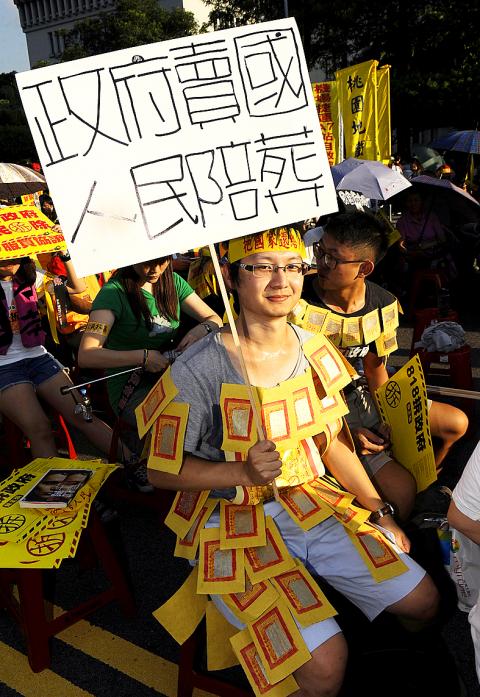Tens of thousands of people rallied yesterday in front of the Presidential Office in Taipei and marched to the Executive Yuan, calling on government officials to apologize for forced land seizures and to stop such policies.
“It is Aug. 18 today, and it was just three years ago, on Aug. 17, that the government promised Dapu [Borough 大埔] residents that their houses would be preserved, while their farmland would be relocated,” Taiwan Rural Front (TRF) president Hsu Shih-jung (徐世榮) said.
“After government officials failed to keep their promises and instead flattened private homes, they ask us to remain calm, but how can we stay calm?” Hsu asked.

Photo: Chen Chih-chu, Taipei Times
The crowd responded with cheering and applause.
“Apologize and compensate!” “Return the land to the people!” they shouted.
Hsu was referring to a negotiation meeting held in 2010 which featured Vice President Wu Den-yih (吳敦義), who was then premier; Premier Jiang Yi-huah (江宜樺), the then minister of the interior; and Miaoli County Commissioner Liu Cheng-hung (劉政鴻), following a series of protests against a plan to clear private land and homes to make way for a science park.

Photo: Chen Chih-chu, Taipei Times
However, despite government promises, four houses in Miaoli County’s Dapu were torn down unexpectedly on July 18, when the county commissioner sent in demolition squads escorted by police officers while the home owners and their supporters were in Taipei protesting the demolition plan.
Asked about the surprise demolition the day after, Liu called it a “god-given opportunity.”
“A month ago, we said that we will tear down the government if they don’t apologize, and now here we are,” said Liao Pen-chuan (廖本全), an associate professor at National Taipei University’s Department of Real Estate and Built Environment.
“We’re not flattening government buildings, but what we are going to do is to destroy the system, which is supposed to protect the disadvantaged. We’re also taking down politicians who are misusing the system to exploit the disadvantaged,” Liao added.
The crowd also set up a mock memorial hall for the county commissioner, with Liu’s portrait in the center, and flowers and incense burners in front of the portrait.
A bag of cow manure was also placed by the mock memorial for people to throw at Liu’s portrait.
“Liu Cheng-hung, cross over the bridge!” the crowd shouted, referring to a traditional belief that the spirit of a newly dead person crosses a bridge into the underworld for judgment.
Since it is believed that the spirits are confused and do not know the way, he or she needs to be reminded to cross the bridge.
Several other organizations for people affected by different development projects also showed up at the rally to show their support and to tell the crowd their stories.
The four families from the demolished houses in Dapu thanked the crowd for their support and promised they will stand with other victims of development projects from now on.
After the rally, the crowd made a stop at the Ministry of the Interior, which is in charge of approving development or urban projects, where they protested outside the building.
The protest was still ongoing as of press time.

CROSS-STRAIT COLLABORATION: The new KMT chairwoman expressed interest in meeting the Chinese president from the start, but she’ll have to pay to get in Beijing allegedly agreed to let Chinese Nationalist Party (KMT) Chairwoman Cheng Li-wun (鄭麗文) meet with Chinese President Xi Jinping (習近平) around the Lunar New Year holiday next year on three conditions, including that the KMT block Taiwan’s arms purchases, a source said yesterday. Cheng has expressed interest in meeting Xi since she won the KMT’s chairmanship election in October. A source, speaking on condition of anonymity, said a consensus on a meeting was allegedly reached after two KMT vice chairmen visited China’s Taiwan Affairs Office Director Song Tao (宋濤) in China last month. Beijing allegedly gave the KMT three conditions it had to

STAYING ALERT: China this week deployed its largest maritime show of force to date in the region, prompting concern in Taipei and Tokyo, which Beijing has brushed off Deterring conflict over Taiwan is a priority, the White House said in its National Security Strategy published yesterday, which also called on Japan and South Korea to increase their defense spending to help protect the first island chain. Taiwan is strategically positioned between Northeast and Southeast Asia, and provides direct access to the second island chain, with one-third of global shipping passing through the South China Sea, the report said. Given the implications for the US economy, along with Taiwan’s dominance in semiconductors, “deterring a conflict over Taiwan, ideally by preserving military overmatch, is a priority,” it said. However, the strategy also reiterated

‘BALANCE OF POWER’: Hegseth said that the US did not want to ‘strangle’ China, but to ensure that none of Washington’s allies would be vulnerable to military aggression Washington has no intention of changing the “status quo” in the Taiwan Strait, US Secretary of Defense Pete Hegseth said on Saturday, adding that one of the US military’s main priorities is to deter China “through strength, not through confrontation.” Speaking at the annual Reagan National Defense Forum in Simi Valley, California, Hegseth outlined the US Department of Defense’s priorities under US President Donald Trump. “First, defending the US homeland and our hemisphere. Second, deterring China through strength, not confrontation. Third, increased burden sharing for us, allies and partners. And fourth, supercharging the US defense industrial base,” he said. US-China relations under

The Chien Feng IV (勁蜂, Mighty Hornet) loitering munition is on track to enter flight tests next month in connection with potential adoption by Taiwanese and US armed forces, a government source said yesterday. The kamikaze drone, which boasts a range of 1,000km, debuted at the Taipei Aerospace and Defense Technology Exhibition in September, the official said on condition of anonymity. The Chungshan Institute of Science and Technology and US-based Kratos Defense jointly developed the platform by leveraging the engine and airframe of the latter’s MQM-178 Firejet target drone, they said. The uncrewed aerial vehicle is designed to utilize an artificial intelligence computer